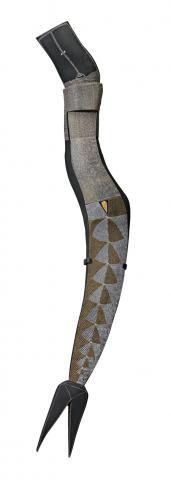YAWK YAWK, 2006
Owen Yalandja
natural earth pigments on carved and shaped hardwood
235.0 cm height
Maningrida Arts and Culture, Northern Territory, cat. 2616-06 (label attached)
The Collection of William and Lucy Mora, Melbourne
This work is accompanied by a certificate of authenticity from Maningrida Arts and Culture
Kuninjku artist Owen Yalandja is a senior member of the Dangkorlo clan, the custodians of an important yawk yawk site. Members of the Dangkorlo clan have established their outstation community at Barrihdjowkkeng near a billabong that is a Yirridjdja moiety sacred site for the yawk yawk spirits.
Yawk yawk or young spirit girls live in this billabong and their shadows can occasionally be seen as they flee the smell of humans who approach the water. They are imagined to have been girls who transformed into mermaid-like figures with fish tails. The identity of the Dangkorlo clan is very much related to their yawk yawk dreaming for which they have spiritual and practical responsibility.
Yalandja's repertoire is almost exclusively concerned with three dimensional representations of the yawk yawk spirits. In the early 1980s, Yalandja was taught carving by his father, renowned artist Crusoe Kuningbal who in the early 1970s, invented the representation of mimih spirit in sculptural form for use in a trade ceremony called Mamurrng. Yalandja and his brother Crusoe Kurddal followed their father's legacy but over the years have found their own styles. In the early 1990s, Yalandja experimented with the dot patterns his father taught him, and created V shaped marks to suggest scales of the watery beings. As Yalandja says: “I make it [yawk yawk] according to my individual ideas... My father used to decorate them with dots. A long time ago, he showed me how to do this. But this style is my own, no one else does them like this.”1 Yalandja only uses kurrajong trees for carving and carefully selects trunks which can be thin and curvilinear to give his figures a sinuous appearance.
1. Owen Yalandja in conversation with Apolline Kohen at Cadell outstation, 4 February 2007, Maningrida Arts and Culture website, maningrida.com
